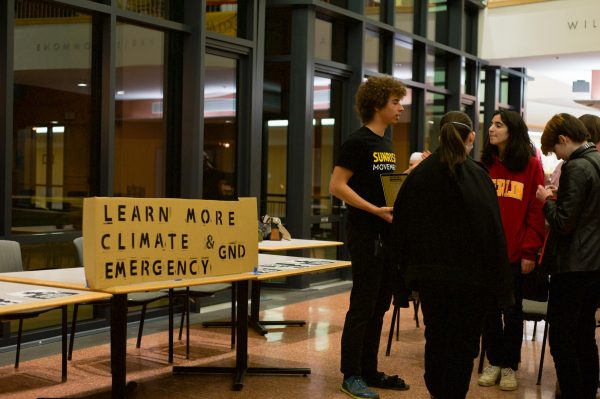Students Abroad Struggled With Remote Learning This Semester
This semester many students have studied at Oberlin remotely due to the COVID-19 pandemic which has created many new obstacles to learning. Perhaps the most challenging experiences were of international students, many of whom are studied from their homes countless miles and multiple time zones away from Oberlin.
Of the 312 international students that enrolled for Oberlin’s spring semester, 146 studied remotely. While administrators, professors, and on-campus students sympathized with the extra hurdles associated with international remote study, the myriad challenges were not always apparent to those living in Oberlin. College third-year Yan Lou, who studied from China, conducted research last semester and compiled a guide to help professors better accommodate remote international students.
Lou says that most professors had a ways to go regarding the level of empathy and understanding they show their remote international students.
“There’s this common line that I get from professors,” Lou said. “The first part is ‘I know that you’re remote, and I’m sorry that you’re dealing with these difficulties.’ But then the second part is ‘You still have to come to class — I take attendance,’ even when the class is at 4 a.m. for me.”
Most international students studying remotely did not impose these time complications on themselves — many factors played a role in each student’s decision to study remotely from their home country.
“For students that are here studying in-person, they remained on campus or at least within the U.S. since March 2020 and therefore have not experienced any issues with travel restrictions, embassy closures, etc.,” Assistant Dean of Students and Director of the International Student Resource Center Josh Whitson wrote in an email to the Review. “Or, they traveled to the U.S. from countries that are not currently under travel restrictions/embassy closures. Or, they were willing and able to travel to a third country to apply for their visa and/or wait 14 days before traveling to the U.S. to bypass embassy closures or travel restrictions.”
Students that are currently remote, conversely, likely left the U.S. last spring and were not allowed to return, or are newly enrolled students who have been unable to travel due to pandemic restrictions.
“Of the 146 international students studying remotely this semester, 107, or 73 percent, are from China, which certainly suggests that the continued U.S. embassy closures there, as well travel restrictions, are likely the most significant factor determining whether or not a student chooses to study remotely, followed by personal considerations.” Whitson wrote.
When Lou began working on their guide to teaching across international lines, they were prepared to take on this project alone until they met College fourth-year Marika Mortimer-Lotke. Mortimer-Lotke is not an international student, and she has been able to use her on-campus access to help compile remote resources for students abroad.
“Last year, when the pandemic struck, I was studying abroad and had to maintain my classes from home, in the U.S.,” Mortimer-Lotke said. “It’s not the same, but it made me begin to think about how remote Oberlin international students might be feeling.”
Lou explained that many professors use Google Docs, which requires many remote international students — particularly those in China — to use Virtual Private Networks to hide their IP address. VPNs are notorious for causing slow connections.
“When I’m in a Zoom meeting, it greatly helps my connection to turn off my VPN,” Lou said. “But if somebody sends a Google Doc link in the chat, I can’t access it. PDFs are way more accessible.”
The pair has identified Blackboard as the most accessible way to reach students from abroad, and their guide pinpoints specific features that can be useful. The insight of Larissa Fekete, who teaches English for Speakers of Other Languages at Oberlin, was instrumental to Lou and Mortimer-Lotke’s research. When Fekete noted that the VPN issue was hindering some students from accessing their student email accounts, she adjusted her methods for sending students course materials.
“I like to post the entire weekly schedule on Blackboard with all the materials necessary to download at the same time each week so students can access it when they know they may have better internet access,” Fekete said.
Lou found that for students who are feeling isolated abroad, social classroom activities or assignments that have a personal component — such as Blackboard journal prompts — can help people stay engaged in their coursework.
Fekete has been enjoying these types of assignments in her class.
“I have something called the ‘fun forum’ where I post prompts such as favorite animal memes, debates about computer games versus video games — those were particularly interesting responses,” Fekete said. “I wanted to imitate the before and after class chatter, because we don’t have that really anymore, but it’s important. It’s mandatory, but it’s low stakes, so I think my students are having fun with it.”
Several of Fekete’s ESOL students are first-years who have never been on campus before and are particularly disappointed to be missing out on campus life. Regardless of year, all Fekete’s students were invited to “virtual visits” with the class’s teacher’s assistants, who took students on 360-degree tours around Oberlin.
Fekete is also offering a 7 a.m. class this semester to accommodate her students.
“With the 12-hour difference, for students studying in China, that is 7 p.m. and way more accessible than a class offered at 2:30 a.m. for them,” Fekete said. “I can wake up at 5 [a.m.] to teach a few times a week, but I could never wake up in the middle of the night to learn.”
Flexible class times would also help students remain present in their home lives. As academic responsibilities weigh on remote international students from afar, a lot of parents have trouble understanding why their children are more withdrawn from home life.
“I can only imagine the … tension if the student is up in the middle of the night taking classes and then sleeps in until noon while their family is awake and moving,” Fekete said. “It would only heighten family distance.”
While college is typically viewed as a time for students to step out as adults and be responsible for themselves, many students who study from home may lose some of that autonomy.
“Almost every international student I spoke to is having issues with their parents right now,” Lou said. “After many of them have spent time in America, a lot of them have changed, and their parents have a hard time fitting their newly adult children into their cultural expectations.”
Fekete was not surprised to hear about these tensions.
“I’ve noticed a reverse culture shock — where students come here excited, then experience culture shock, decide everything here sucks, and then it all levels out when they make friends,” Fekete said. “But then everything is different at home as people moved on without them and they changed from being at Oberlin. This must be even more stark as students stay for longer than the summer.”
Lou noted that professors who made the first move often wound up being the most effective in reaching their international students abroad.
“With cultural differences, a lot of international students aren’t used to reaching out to professors for assistance,” Lou said. “That’s why it’s important for professors to reach out to them, especially first-years.”
Looking ahead, it appears that many international students will be allowed to rejoin students on campus in the fall. On Tuesday, the Secretary of State made the determination that students from many countries, including China, will be able to continue or commence international studies in the US from Aug 1 forward.
“I’m very hopeful with the vaccine rollout that embassy closures and travel restrictions will not be an issue for international students for the Fall 2021 semester,” Whitson wrote. “However, if the last 14 months have taught me anything, it’s that it’s very difficult to predict exactly what will happen. Much will depend on the COVID situation as we get closer to the fall, both within the US and abroad.”






